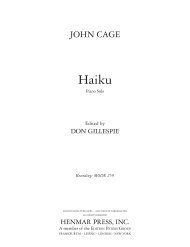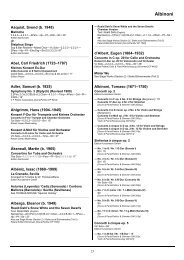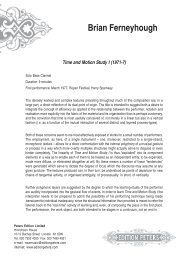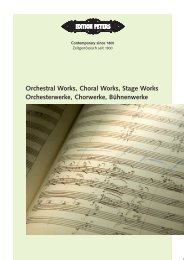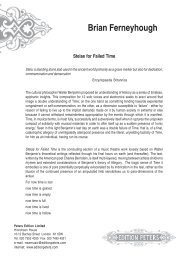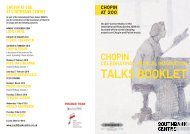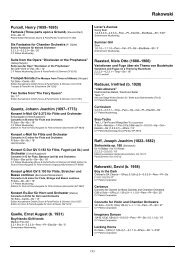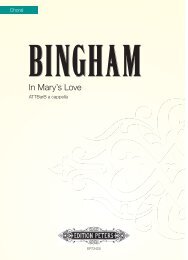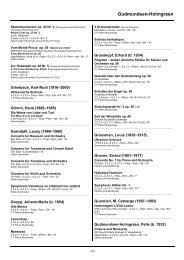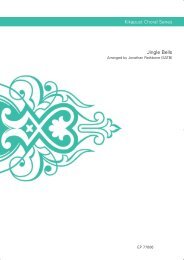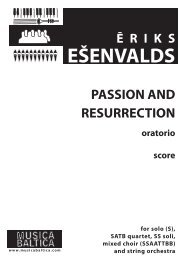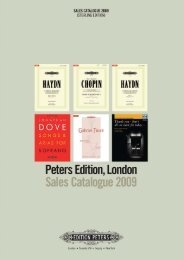Haydn String Quartets - Edition Peters
Haydn String Quartets - Edition Peters
Haydn String Quartets - Edition Peters
You also want an ePaper? Increase the reach of your titles
YUMPU automatically turns print PDFs into web optimized ePapers that Google loves.
Simon Rowland-Jones<br />
Performer, editor, composer and teacher, Simon Rowland-Jones has always led a very busy, all-embracing<br />
musical life. He was founder violist of the Chilingirian Quartet, in which he played for a total of ten years,<br />
and he has also performed with many other leading chamber groups, including the Nash Ensemble.<br />
As a soloist, he made a highly-acclaimed Carnegie Hall début in 1979 and has since given many<br />
recitals and made a number of solo recordings. His CDs, on the Meridian and Etcetera labels, include the<br />
first-ever complete version of the Bach Cello Suites on viola. <strong>Peters</strong> <strong>Edition</strong> published his thoroughlyresearched<br />
viola transcription of the suites shortly after the recording was made. After this, he went on to<br />
make a new critical/performing edition of the <strong>Haydn</strong> <strong>String</strong> <strong>Quartets</strong>, also for <strong>Peters</strong> <strong>Edition</strong>. This massive<br />
ten-year project is now almost finished, with the edition being used by string quartets around the world.<br />
Simon Rowland-Jones has, from a very early age also been a composer. Receiving lessons from Nadia<br />
Boulanger while a student at the Yehudi Menuhin School, he now spends an ever-increasing part of his<br />
life writing chamber music and works for viola. His many compositions, which include three string<br />
quartets, a string trio, a piano quartet and ‘A Turn Outside’, (a musical adaptation of a play by Stevie<br />
Smith commissioned by Dame Josephine Barstow), have become an integral part of his performing career.<br />
Simon Rowland-Jones also teaches viola and chamber music at the Royal Northern College of Music and<br />
is co-director of the North Norfolk Music Festival.<br />
David Ledbetter is Research Fellow at the<br />
Royal Northern College of Music. He has a<br />
particular interest in how an understanding<br />
of context, style and structure may deepen<br />
and enrich performance. His publications<br />
include Harpsichord and Lute Music in<br />
17th-Century France (Macmillan), Continuo<br />
Playing According to Handel (Oxford<br />
University Press), Bach’s Well-tempered<br />
Clavier (Yale University Press), and a<br />
forthcoming book on Bach’s instrumental<br />
solos (also Yale University Press).<br />
<strong>Haydn</strong> <strong>String</strong> <strong>Quartets</strong><br />
<strong>Haydn</strong>, <strong>String</strong> Quartet Op. 20 No. 6,<br />
Movement I, bars 93–104: the composer’s autograph.<br />
Reproduced by permission of the<br />
Gesellschaft der Musikfreunde, Vienna.<br />
<strong>Haydn</strong> <strong>String</strong> <strong>Quartets</strong> (Urtext Full Score & Parts)<br />
EP 7594 Op. 20 Hob.III: 31–36 £34.95<br />
EP 7595 Op. 33 Hob.III: 37–42 £34.95<br />
EP 7615 Op. 50 Hob.III: 44–49 £34.95<br />
EP 7616 Op. 54; Op. 55 Hob.III: 57–62 £34.95<br />
EP 7617 Op. 64 Hob.III: 63–68 £34.95<br />
EP 7618 Op. 71; Op. 74 Hob.III: 69–74 £34.95<br />
EP 7619 Op. 76 Hob.III: 75–80 £34.95<br />
EP 7620 Op. 77; Op. 103; Op. 42 In preparation<br />
The Publishers and Editors gratefully<br />
acknowledge the generous support for<br />
editorial research given by the Radcliffe<br />
Trust, the Arts and Humanities Research<br />
Board, the Royal College of Music and the<br />
Royal Northern College of Music.<br />
A New Urtext Performing <strong>Edition</strong><br />
Edited by Simon Rowland-Jones<br />
Editorial Consultant David Ledbetter<br />
LONDON • FRANKFURT/M •LEIPZIG • NEW YORK<br />
www.editionpeters.com<br />
<strong>Peters</strong> <strong>Edition</strong> Ltd<br />
2–6 Baches Street<br />
London<br />
N1 6DN<br />
Tel: +44 (0) 20 7553 4000<br />
Fax: +44 (0) 20 7490 4921<br />
Email: sales@editionpeters.com<br />
Web: www.editionpeters.com<br />
C. F. <strong>Peters</strong> · Musikverlag<br />
Kennedyallee 101<br />
D - 60596<br />
Frankfurt/Main<br />
Tel: 49 (0)69 - 63 00 99 - 0<br />
Fax: 49 (0)69 - 63 00 99 - 54<br />
Mail: info@edition-peters.de<br />
Web: www.edition-peters.de<br />
LONDON • FRANKFURT/M •LEIPZIG • NEW YORK
A New Urtext Performing <strong>Edition</strong><br />
Edited by Simon Rowland-Jones<br />
Editorial Consultant David Ledbetter<br />
<strong>Haydn</strong> <strong>String</strong> <strong>Quartets</strong><br />
Introducing his new player-friendly edition of the <strong>Haydn</strong> <strong>Quartets</strong>,<br />
Simon Rowland-Jones writes: ‘There can be no such thing as a final,<br />
perfect version; <strong>Haydn</strong> left too many questions open.’ The new <strong>Peters</strong><br />
<strong>Edition</strong> is founded upon this honest assessment. By heightening our<br />
awareness of the questions that remain ‘open’, this edition liberates<br />
the interpretative inspiration of performers as never before.<br />
Each Volume Includes:<br />
Guidance for Performers: as well as giving the historical background to<br />
the quartets, David Ledbetter’s preface to each volume, written in collaboration<br />
with Simon Rowland-Jones, contains a treasure trove of information about<br />
all aspects of performance practice.<br />
Genre, Style and Character: of all his works, the quartets are where <strong>Haydn</strong><br />
gave full rein to his quick-witted, experimental approach to musical materials;<br />
an understanding of his highly-sophisticated language is vital for the expressive<br />
projection of the music.<br />
Tempo and Rhythm: gives practical advice regarding <strong>Haydn</strong>’s tempo<br />
indications and notational practices.<br />
Articulation and Bowing: highlights how <strong>Haydn</strong>’s methods of notating<br />
articulation evolved during his career, with particular emphasis on the distinction<br />
between staccato dots and portato strokes.<br />
Ornamentation: general principles are illustrated by reference to specific<br />
examples within each volume.<br />
For example:<br />
Dynamics: advice is offered for idiomatic interpretation of <strong>Haydn</strong>’s dynamics,<br />
and options considered where they are absent.<br />
Full Score: included with the parts – invaluable for performance preparation.<br />
Many aspects of <strong>Haydn</strong>’s creative ingenuity were misunderstood by his original<br />
publishers. Unfortunately, some of these ‘corrections’ have been perpetuated to<br />
the present day. One of the most striking examples of this is in the ‘Tempo di<br />
Menuet’ movement from Op. 50 No. 5. Here, the erroneous addition of an F minor<br />
key signature to the ‘trio’ has the effect of blunting the otherwise unexpected Db<br />
in bar 44. Unusually, and tellingly, <strong>Haydn</strong> does not indicate arepeat in this first<br />
section of this trio, surely confirming his intention to serve up a one-off surprise<br />
by the swerve to Ab major in bars 44–46.<br />
The trio as it has conventionally appeared...<br />
Critical Commentary<br />
In the extensive Critical Commentary to each volume,<br />
the most authoritative early sources for <strong>Haydn</strong>’s<br />
quartets are carefully evaluated and full details<br />
of their variant readings given for comparison.<br />
Naturally, the composer’s autograph, where extant,<br />
assumes pre-eminence, but many other primary<br />
sources are considered, and secondary sources<br />
drawn upon where appropriate.<br />
Typical Critical Commentary entry, (Op. 20 No. 1):<br />
Simon Rowland-Jones is exceptionally attentive<br />
to the possibility that many of the apparent<br />
inconsistencies in <strong>Haydn</strong>’s autographs may be<br />
deliberate manifestations of the composer’s fertile<br />
and often mischievous musical imagination, rather<br />
than merely oversights on his part. In the example<br />
below, <strong>Haydn</strong>’s autograph clearly indicates nonmatching<br />
bowing between viola and cello, exactly<br />
imitated by the violins in the following bars. In<br />
previouseditionsthisplayfulnesshasbeenneutralised.<br />
With the new <strong>Peters</strong> <strong>Edition</strong>, players can now make<br />
their own decisions as to what <strong>Haydn</strong> intended.<br />
...and how it appears, in the new <strong>Peters</strong> <strong>Edition</strong>, according to <strong>Haydn</strong>’s autograph:



